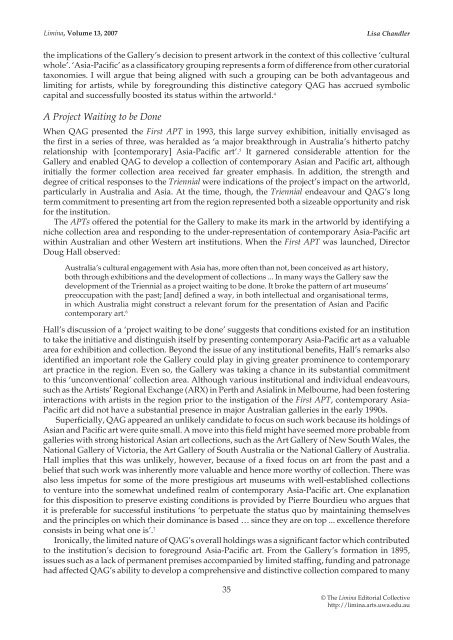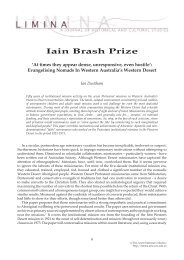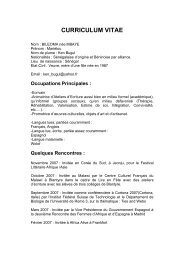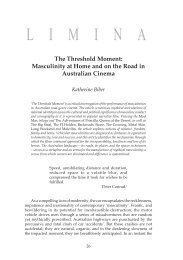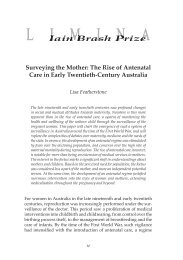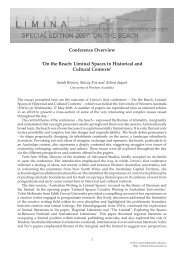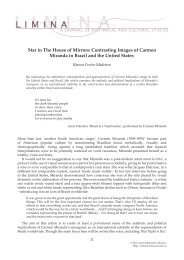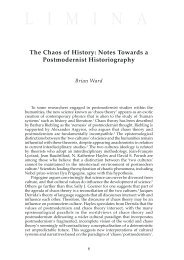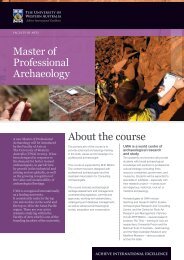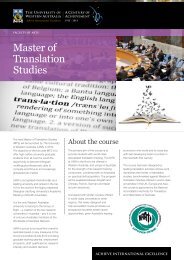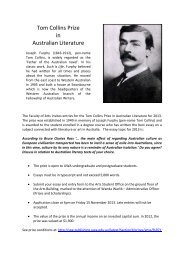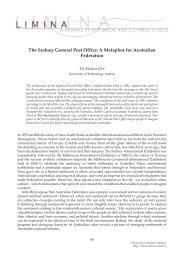'The Asia-Pacific Effect': Geo-Cultural Grouping at the ... - Past volumes
'The Asia-Pacific Effect': Geo-Cultural Grouping at the ... - Past volumes
'The Asia-Pacific Effect': Geo-Cultural Grouping at the ... - Past volumes
You also want an ePaper? Increase the reach of your titles
YUMPU automatically turns print PDFs into web optimized ePapers that Google loves.
Limina, Volume 13, 2007<br />
Lisa Chandler<br />
<strong>the</strong> implic<strong>at</strong>ions of <strong>the</strong> Gallery’s decision to present artwork in <strong>the</strong> context of this collective ‘cultural<br />
whole’. ‘<strong>Asia</strong>-<strong>Pacific</strong>’ as a classific<strong>at</strong>ory grouping represents a form of difference from o<strong>the</strong>r cur<strong>at</strong>orial<br />
taxonomies. I will argue th<strong>at</strong> being aligned with such a grouping can be both advantageous and<br />
limiting for artists, while by foregrounding this distinctive c<strong>at</strong>egory QAG has accrued symbolic<br />
capital and successfully boosted its st<strong>at</strong>us within <strong>the</strong> artworld. 4<br />
A Project Waiting to be Done<br />
When QAG presented <strong>the</strong> First APT in 1993, this large survey exhibition, initially envisaged as<br />
<strong>the</strong> first in a series of three, was heralded as ‘a major breakthrough in Australia’s hi<strong>the</strong>rto p<strong>at</strong>chy<br />
rel<strong>at</strong>ionship with [contemporary] <strong>Asia</strong>-<strong>Pacific</strong> art’. 5 It garnered considerable <strong>at</strong>tention for <strong>the</strong><br />
Gallery and enabled QAG to develop a collection of contemporary <strong>Asia</strong>n and <strong>Pacific</strong> art, although<br />
initially <strong>the</strong> former collection area received far gre<strong>at</strong>er emphasis. In addition, <strong>the</strong> strength and<br />
degree of critical responses to <strong>the</strong> Triennial were indic<strong>at</strong>ions of <strong>the</strong> project’s impact on <strong>the</strong> artworld,<br />
particularly in Australia and <strong>Asia</strong>. At <strong>the</strong> time, though, <strong>the</strong> Triennial endeavour and QAG’s long<br />
term commitment to presenting art from <strong>the</strong> region represented both a sizeable opportunity and risk<br />
for <strong>the</strong> institution.<br />
The APTs offered <strong>the</strong> potential for <strong>the</strong> Gallery to make its mark in <strong>the</strong> artworld by identifying a<br />
niche collection area and responding to <strong>the</strong> under-represent<strong>at</strong>ion of contemporary <strong>Asia</strong>-<strong>Pacific</strong> art<br />
within Australian and o<strong>the</strong>r Western art institutions. When <strong>the</strong> First APT was launched, Director<br />
Doug Hall observed:<br />
Australia’s cultural engagement with <strong>Asia</strong> has, more often than not, been conceived as art history,<br />
both through exhibitions and <strong>the</strong> development of collections ... In many ways <strong>the</strong> Gallery saw <strong>the</strong><br />
development of <strong>the</strong> Triennial as a project waiting to be done. It broke <strong>the</strong> p<strong>at</strong>tern of art museums’<br />
preoccup<strong>at</strong>ion with <strong>the</strong> past; [and] defined a way, in both intellectual and organis<strong>at</strong>ional terms,<br />
in which Australia might construct a relevant forum for <strong>the</strong> present<strong>at</strong>ion of <strong>Asia</strong>n and <strong>Pacific</strong><br />
contemporary art. 6<br />
Hall’s discussion of a ‘project waiting to be done’ suggests th<strong>at</strong> conditions existed for an institution<br />
to take <strong>the</strong> initi<strong>at</strong>ive and distinguish itself by presenting contemporary <strong>Asia</strong>-<strong>Pacific</strong> art as a valuable<br />
area for exhibition and collection. Beyond <strong>the</strong> issue of any institutional benefits, Hall’s remarks also<br />
identified an important role <strong>the</strong> Gallery could play in giving gre<strong>at</strong>er prominence to contemporary<br />
art practice in <strong>the</strong> region. Even so, <strong>the</strong> Gallery was taking a chance in its substantial commitment<br />
to this ‘unconventional’ collection area. Although various institutional and individual endeavours,<br />
such as <strong>the</strong> Artists’ Regional Exchange (ARX) in Perth and <strong>Asia</strong>link in Melbourne, had been fostering<br />
interactions with artists in <strong>the</strong> region prior to <strong>the</strong> instig<strong>at</strong>ion of <strong>the</strong> First APT, contemporary <strong>Asia</strong>-<br />
<strong>Pacific</strong> art did not have a substantial presence in major Australian galleries in <strong>the</strong> early 1990s.<br />
Superficially, QAG appeared an unlikely candid<strong>at</strong>e to focus on such work because its holdings of<br />
<strong>Asia</strong>n and <strong>Pacific</strong> art were quite small. A move into this field might have seemed more probable from<br />
galleries with strong historical <strong>Asia</strong>n art collections, such as <strong>the</strong> Art Gallery of New South Wales, <strong>the</strong><br />
N<strong>at</strong>ional Gallery of Victoria, <strong>the</strong> Art Gallery of South Australia or <strong>the</strong> N<strong>at</strong>ional Gallery of Australia.<br />
Hall implies th<strong>at</strong> this was unlikely, however, because of a fixed focus on art from <strong>the</strong> past and a<br />
belief th<strong>at</strong> such work was inherently more valuable and hence more worthy of collection. There was<br />
also less impetus for some of <strong>the</strong> more prestigious art museums with well-established collections<br />
to venture into <strong>the</strong> somewh<strong>at</strong> undefined realm of contemporary <strong>Asia</strong>-<strong>Pacific</strong> art. One explan<strong>at</strong>ion<br />
for this disposition to preserve existing conditions is provided by Pierre Bourdieu who argues th<strong>at</strong><br />
it is preferable for successful institutions ‘to perpetu<strong>at</strong>e <strong>the</strong> st<strong>at</strong>us quo by maintaining <strong>the</strong>mselves<br />
and <strong>the</strong> principles on which <strong>the</strong>ir dominance is based … since <strong>the</strong>y are on top ... excellence <strong>the</strong>refore<br />
consists in being wh<strong>at</strong> one is’. 7<br />
Ironically, <strong>the</strong> limited n<strong>at</strong>ure of QAG’s overall holdings was a significant factor which contributed<br />
to <strong>the</strong> institution’s decision to foreground <strong>Asia</strong>-<strong>Pacific</strong> art. From <strong>the</strong> Gallery’s form<strong>at</strong>ion in 1895,<br />
issues such as a lack of permanent premises accompanied by limited staffing, funding and p<strong>at</strong>ronage<br />
had affected QAG’s ability to develop a comprehensive and distinctive collection compared to many<br />
35<br />
© The Limina Editorial Collective<br />
http://limina.arts.uwa.edu.au


